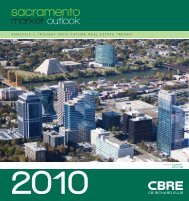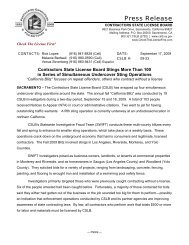Plan for the Closure of Lanterman Developmental Center
Plan for the Closure of Lanterman Developmental Center
Plan for the Closure of Lanterman Developmental Center
Create successful ePaper yourself
Turn your PDF publications into a flip-book with our unique Google optimized e-Paper software.
an example <strong>of</strong> how well-planned, adequately funded, and collaborative ef<strong>for</strong>ts<br />
can achieve such outcomes.<br />
“As you know, regional centers were established to develop local communitybased<br />
service systems as an alternative to costly state-operated institutions. A<br />
1969 report to <strong>the</strong> Legislature about <strong>the</strong> first two pilot regional centers observed<br />
that “Over <strong>the</strong> years, approximately 2,000 to 3,000 Cali<strong>for</strong>nia families at <strong>the</strong> point<br />
where <strong>the</strong>y were no longer able to care <strong>for</strong> <strong>the</strong>ir retarded member applied<br />
annually <strong>for</strong> services from one <strong>of</strong> <strong>the</strong> four State hospitals <strong>for</strong> <strong>the</strong> mentally<br />
retarded. Until 1965, <strong>the</strong> State hospital and post-hospital leave programs were<br />
<strong>the</strong> only alternatives open to families, whe<strong>the</strong>r or not hospital care was needed<br />
by <strong>the</strong> individual or desired by his family. During <strong>the</strong> 1965 legislative session, <strong>the</strong><br />
Regional <strong>Center</strong> program was established to answer <strong>the</strong> pleas <strong>of</strong> families who<br />
were eager to keep <strong>the</strong>ir mentally retarded family member home and/or in <strong>the</strong><br />
community.” Thus, from <strong>the</strong>ir inception, a primary regional-center function has<br />
been to deflect individuals from placement in state developmental centers<br />
(previously called “state hospitals”) by creating community-based alternatives,<br />
and to transition those living in state developmental centers into <strong>the</strong> community.<br />
“The regional-center “experiment” has, obviously, been very successful, as<br />
evidenced by <strong>the</strong> steady decline in <strong>the</strong> number <strong>of</strong> individuals living in institutions<br />
and <strong>the</strong> closure <strong>of</strong> three large state developmental centers since <strong>the</strong> mid-1990s.<br />
In 1968, <strong>the</strong>re were 13,355 individuals living in state developmental centers and<br />
a legislative committee at that time reported “…that thousands <strong>of</strong> children are on<br />
waiting lists <strong>for</strong> State hospitals…” Today <strong>the</strong> developmental centers serve only<br />
about 2,100 individuals, despite <strong>the</strong> state’s general population increase from 19.4<br />
million in 1968 to about 38 million in 2009. Thus, since <strong>the</strong> establishment <strong>of</strong> <strong>the</strong><br />
first regional centers, <strong>the</strong> number <strong>of</strong> individuals in Cali<strong>for</strong>nia residing in<br />
developmental centers has been reduced from one in 1,453 <strong>of</strong> <strong>the</strong> general<br />
population to one in 18,327 today. However, <strong>the</strong> costs <strong>of</strong> placing and maintaining<br />
individuals with medical and/or behavioral characteristics in <strong>the</strong> community are<br />
not insignificant, although much less than serving <strong>the</strong>se same individuals in state<br />
developmental centers.<br />
“Section 4418.1(a) <strong>of</strong> <strong>the</strong> Wel. & Insti. Code states that “The Legislature<br />
recognizes that it has a special obligation to ensure <strong>the</strong> well-being <strong>of</strong> persons<br />
with developmental disabilities who are moved from state hospitals to <strong>the</strong><br />
community.” ARCA believes that <strong>the</strong> Department, all regional centers, family<br />
members, and <strong>the</strong> provider community share this same obligation. With this vital<br />
obligation in mind, ARCA and its member regional centers look <strong>for</strong>ward to<br />
working with <strong>the</strong> Department in its planning to close <strong>Lanterman</strong> <strong>Developmental</strong><br />
<strong>Center</strong>.”<br />
35
















